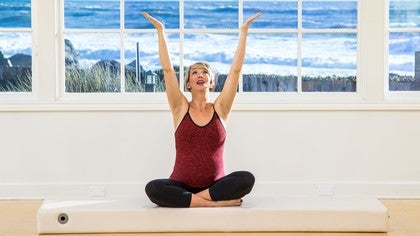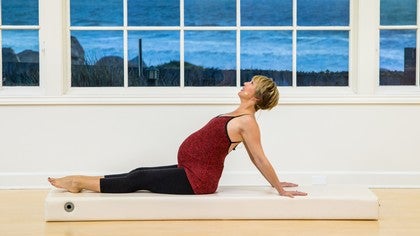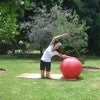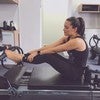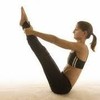Description
About This Video
Transcript
Read Full Transcript
Okay. This is our first class in what I'm calling our Palase birthing series. So if you're joining me for the first time, I want you to take a little pause and I want you to go back and just hang with me and watch the intro to this entire series so that you kind of know what the intention is behind these classes and kind of what yourself, what you're getting yourself into. So this is one of four classes that are specifically designed to help you kind of understand how you can translate PyLadies into your labor and birth experience. This first class is a little less movement based and a little bit more explanation based if you will.
So I'm going to spend some time explaining to you about what some of your body position options may be. Now again, this really just depends on your breathing, uh, circumstances and your breathing choices, uh, from anywhere from giving birth at home to having a hospital birth. But I just want to show you what some of your options are. For some of you, you might be laboring at home up until to a certain point. And then you go to the hospital. Um, you know, there's going to be a lot of different uh, options and variations in how we all give birth. But I want to show you some of your options that you have in body positions and why they might be helpful for you during your labor and birth experience. So the first thing I want to point out here is one of the best birthing tools is going to be having access to a fitness ball or a stability ball, whatever you want to call it.
Just a big soft cushy ball is kind of what you want to have for you. And this is going to be really, really helpful from when you began your pregnancy, or excuse me, of your labor all the way through, quite honestly, until you push the baby out. So this is going to be a really helpful tool for you. So we're going to start with that. So what I'm going to do is I'm going to go through a bunch of different body positions and I'm going to explain why they're so, why they can be helpful for you. And then within that, what you'll see in the other classes beyond this first class is we're going to go through some of these body positions and y'all should see some more of the movement vocabulary that you can do within these body positions.
So just kind of know what you're getting here. So get out your pen and paper and write some notes because this is what you want to be doing during this class. So the first thing we're going to explore is our seated position with our stability bomb. So you have two options you can use here. So you can have your legs crossed in front of you or you can sit with your legs apart. I'm on the floor, you can place a towel or a cushion or a pillow over your bottom of fulfills a little bit better to be lifted up. Like I'm lifted up on the mat here, which is a little bit gentler on my hips. Whatever works for you. And this is a really great position to utilize. Well really, honestly, throughout the all of labor.
But it's a really great position to utilize in between contractions that as we know, constructions are going to start really mild at the beginning of labor and then they just intensify as labor progresses. So I'm actually gonna show it to with my legs open my feet on the mat. So what you want to do is you want to drape your body over the ball and kind of give the ball a big hug and just gently place your ear on the ball here. So what you're doing is you're basically going to be giving your body weight to the ball and you're going to just be letting your pelvis sit in a natural position. Let your belly kind of hang in a natural position here. So within this, we're going to actually use this as a kind of a, an element to relax onto. And again, like I said, to support your body weight and then from within this you can kind of do some rocking or swaying motions back and forth. Um, you could put your forehead down on your arms, you could rock back and forth. Going forward and back, you could do circles with your torso, with the support of the ball.
And so this is a really great position to kind of experience some of those and early to mid, um, parts of labor. And it's nice because what I've done and what I've seen women do is when they're in the throws of a contraction, which can last anywhere from, you know, 15 to 60 seconds, it can kind of be a great way to just kind of let your body rest on the ball and breathe through those contractions. So when your contraction is over, right, then that's your time that you can kind of use to kind of more or less kind of recover from that kind of contraction. And that's where kind of some of the mobility comes into play. So that's going to be one of your first options with the ball in a seated position. So I'm going to go ahead and just set it to the sides here. Then I want to move into a kneeling position. Is it going to go away?
That's okay. I want to move into a kneeling position. Now, a little background here, this is exactly how I gave birth to my second son in this position. He came into the world when I was in this position. So it's a really wonderful birthing position. And the reason is is because of the way your pelvis aligns when you're in that position. So as you can see here, I have my, um, my, my tell Moana, my sacrum are not really up per se, but they're a little bit wider when I'm sitting on my bottom, they can kind of tuck underneath me. So I'm giving them the space to actually open and move because as we push the baby out and as labor progresses, the actually the, the sacred and the telephone actually will move up to allow space for that baby to go through. So this gives the Pellis the freedom to be able to do that.
So a kneeling position is really helpful. This is also why in some of the other classes here, we're going to talk about the need for shoulder endurance and strength, spinal endurance and strength. And then obviously of course the work that's going on in the pelvis as well. So this position becomes really advantageous for birth. Now here I am on my wrist, which can be challenging for some women during there might be a little bit of pain there. You can go on your fist if that's comfortable for you.
Another option is to go down onto your forearms. Now here you're kind of changing the laws of gravity. So this position would be more advantageous for um, laboring. Um, but birthing, this isn't gonna work so well because the baby now has to go up and that's going to be a little bit harder. But this is a really great position to kind of, um, you know, to keep that pelvis open. And during some of those early and mid stages of labor, this is a very powerful birthing position.
Another thing you want to consider in this position is some of the rotation of your leg bones or your femurs. So if you rotate your legs inward, it's actually going to widen your sitz bones or your issial tuberocities. If you cross your ankles or you rotate your femurs externally, it's actually going to make your sitz bones be a little bit more narrow. So what do you think you want for having a baby? You want more with more openness of your pelvis. So parallel to even a little bit of internal rotation of your femurs of your thigh bones are going to be really, really helpful.
So in this position we are going to see in some of our other classes, we're going to do a lot of mobility exercises here and some strengthening and endurance exercises. They're going to help you be able to prepare to stay in this position. When I gave birth to my second son in this position, I was in this position for about um, 30 35 minutes. And I actually, I was actually in the bathtub, so I have my elbows up on the bathtub so I was a little bit higher. So I even had more of gravity coming down. And that's from going into my next explanation is using Zeba.
So you can mimic this kneeling position. Take some of the pressure off of your wrist, lift torso up a little bit and you can drape your chest over the ball. So now all of a sudden I don't have to depend on my shoulders so much for that support and that stability and that endurance. I have the ball for that. And then of course I can move a little bit differently, a little bit more freely. As you can see, my pelvis is a little bit lower than my chest, so that's going to have gravity. That's going to help as well.
So this is a willy really great position to Labor in and to burden as well. And another reason why other than that it just opens the pelvis is it doesn't put a lot of strain on the paraniem or on the pelvic floor muscles. And I'll explain that a little bit more as we go into some of our other positions, like our deep squats and why they're helpful and why they cannot be helpful in some cases. But this is really nice because it doesn't pull those paraniem and those pelvic floor muscles. So taught with the added pressure of the baby coming through the birth canal.
It's really nice because it gives that open quality without adding extra pressure than already in great amount of pressure that is already going on the pelvis and the pelvic floor muscles. So those are going to be some of your options with your stability ball and your kneeling position. And I'm going to show you some options that we have with a chair. So moving into some other options that we have. One other option that you have with the ball and then of course using a chair and a chair could also mean the end of a bed, whether it's your bed at home or it's a hospital bed.
It could be your partner's lap and this can be anything or anybody that has a little bit more height thing you are. So the first thing is we sat on the floor with the ball, we did some kneeling with the ball and now we're going to sit on the ball. And um, I'm using the chair to again, give you something to support your upper body on. Because when you're in the throws of labor, um, again, we're not literally doing like these PyLadies exercises per se, but what we're doing is we're incorporating the elements that we worked on and some of the benefits that we received, but it's really important during labor and birth that we know when to relax and we know when to just let our body do its work naturally and to provide the environment for our body to do that work. So having the ball underneath you, you're at this really great comfortable position in your hip joints.
This is a great alternative for you if you don't feel comfortable sitting on the floor. I have this really cushy support of my pelvis and my pelvic floor and as you can see behind me, my sacred and my tailbone are complete, my are completely free. There's nothing inhibiting them, so they're open. It's up. I'm in more of an anterior tilt of my pelvis and this opening up my pelvis and my pelvic floor muscles. My stance with my legs is wide. Again, to provoke that openness. And then when with the tear or the bed, I'm letting my upper body relax here and so I can, you know, in this position I can do all sorts of movements with my body as I'm experiencing those contractions. Um, during the contractions, you may or may not want to move your body. You might wish to want to focus on breath and focus on relaxation and focus on letting those contractions help to push the baby down into the birth canal. Or you might want to move in between contractions might be your time for quote unquote recovery for you and your baby because contractions are very stressful on the baby as well.
So you can take that time to kind of undulate your body and breathe. Another crate reason, and I'll speak to this a little bit more in one of our other classes is when you're in these forward leaning positions, so great way for your birthing partner to come and give you some physical touch, whether it's just touching your back or giving you a touch on your shoulders, giving you a little bit of support that's going to help you relax and feel comfortable and feel connected with another person going through this process with you. So using the chair for that, it's going to be really helpful. You can also turn the chair around or get something lower and if you feel more comfortable you can be even a little bit lower on your forearms. So moving forward and back here, moving into circles, um, you know, if I wanted to come up and do a little bit of opening of my chest, I could, um, you know, if I needed to just sit with my hands on my knees, having a baby is so primal, your body is just going to take over. And if you're in the circumstance or situation where you have access to tools like this, it is really going to help your labor experience and make it really wonderful.
So that's going to be our options with our stability ball. And a lot of hospitals now have access to balls. So we're just going to sweep that guy away and we're going to talk a little bit about sitting on a chair. Now a chair is great, it's going to mimic our ball, but we're not going to have that cushy feedback that we get from the ball. That soft texture, right? We have something a little bit harder. A lot of women, you hear these stories about women who sit on the toilet and they like to labor on the sitting on the hard surface of the toilet with the space in between.
And there's a very specific reason for that. It opens the pelvis without putting too much strain on the pelvic floor musculature, and it's a great way for the moment to position her body so that the baby can descend down into the birth canal while the conjunctions happen. So this is good to do with a chair as well. And again, it could be something like leaning forward. And I know I just pushed the ball away, but I could also reverse the roles and I can lean on a ball or I can lean on a bed as well. But this position is great because it tends to open up the, um, again, the issial tuberocities sits bones and open up the sacrament and the pelvis.
It keeps my body being a little bit up. It keeps gravity into the equation here and the healthfulness of gravity into labor and birth as well. So sitting on a chair is another option that you have. And again, it doesn't mean even though you don't have the mobility of the surface that you're sitting in like you do with a ball, it's a stable surface. It's not going to move with you, but you as can still recreate some of the movement vocabulary that you've learned in your prenatal classes. Some of the movement vocabulary that I'll be showing you as well.
So sitting on a chair, it can be really advantageous for labor. Obviously you're not going to have a baby sitting on a chair because maybe no where to go. So it's one of those tools that you're gonna be able to use for labor. The next one I want to explore is some of our semi squatting or standing positions with a chair, a wall or your breathing partner. So this chair is a little bit low, but I still going to be able to get the point across for you.
You'll see a lot of images, especially of um, kind of natural home birds were women are kind of in these supported, um, more like higher squatted positions, not in these deep squat positions. So they're kind of in these supported positions here where again, you can see the effectiveness on the pelvis and they have that support of the upper body. Again, if I were to have, um, my husband or my birthing partner here, I would be in a a little bit higher and maybe my arms would be draped on his shoulders and he would have his arms underneath my arms and he would be supporting my upper body. But again, you can see all of the position is screaming at what we want. Pelvis opening, gravity, um, enough muscle relaxation but not too much stress on the muscles. Um, because I see natural stress because of the natural stress that's going to happen as the baby pushes through the birth canal. So these kind of, you know, semi squat positions with, um, you know, our head forward on a chair or propped up against a wall or popped up against our partner is going to be really helpful here. So again, what I like about this position too is that I can do little bit more dramatic movements as I move through the labor process. So as I go in between the contractions, I can make my movements a little bit bigger, I think a little bit deeper with my knees bending and my hips and Jing.
So it changes some of the orientation that we're limited to when we're seated or we're seated on the ball or seated on the floor, I can get a little bit better. I can get a little jucier with my, with my movement. So that's why the chair or the wall or your breathing partner is also great for that as well. So those are going to be some of your options. Your put body position options sitting on a ball, sitting in a chair or standing with support for something like a chair or your partner. So let's move on to our next ones. Now there is some women and in some situations where kind of squatting positions become really advantageous and actually some women really enjoy it and there's some advantages to using a squatting position.
So this is why in some of the other parts of this series, we're actually going in practice gaining some strength and endurance in some of these squat positions because they can become really important. So you'll see that some labor options are going to be to stand up against a wall. Or if you have a partner and you're connecting with your birthing partner, again, your partner would stand behind you with their arms draped underneath your arms and you would be leaning up against them. And they're a lot cozier than a cold wall. But I don't have my burden partner here. So the wall gets me today. So you know, again, as you can see a pattern that we're repeating here with some of these positions, positions that are going to promote openness of the pelvis, enough openness and mobility of the pelvic of the musculature and then also the help and the um, the advantages of using gravity. So here's going to be your kind of wall squat or your semi squat position that you're going to have. So again, I'm not sitting with my pelvis tucked underneath me, I'm kind of in this neutral position. My sacred, when they tell are pointing straight down by pubic synthesis is pointing straight down or straight forward, however you want to imagine it.
And they have this open position. So if I had my, my birthing partner behind me, I could lean my head up against their shoulders so I could really relax and I can breathe. And here is a great position because you'll see the contractions happening. You'll start to feel that. And within this I can completely let my body be supported by another entity, whether it's an inanimate odds are it's like a wall or a human being and I can use my body to kind of move and sway and do whatever feels natural. Now really popular position to Labor in is actually a deep squat.
So this is kind of what we hear about. Um, kind of like the way women use to give birth, right? This is like kind of a kind of a very primal way that women would labor and birth. And the reason for that again is that there's just this massive amount of openness on the pelvis, this massive width between the two sides of the pelvic bones. The issue tuberosities are really wide and deep and that also has that added pressure that goes down from the squat position. Now in all of my research, in my experience, a deep squat is very helpful for labor, but not necessarily in a lot of cases would it be the best option for birth? Meaning the pushing process when you're pushing the baby out and all you have to do is get into a squat to kind of understand a little bit more why some people hold that opinion. Now a lot of people don't, but some people do.
So you have to choose what's right for you is when I'm in this position, my parenting and muscles and my deep pelvic floor muscles are being stretched to their Max. So they're being stretched really wide. And then on top of that, the baby's head is stretching them even more and putting even more pressure on them. Now in some position, uh, opinions of midwives or Doulas or ob Gyn, that might not be, that opens you up a little bit more vulnerable for terrorists or things like that, that things that you necessarily don't want to happen to happen. So I'm not saying it's good or bad, I'm just saying we need to know why we're exploring some of these different positions. So here I am an a deep squat supported against the wall, which is really nice. So here, why aren't we thinking I would use this during labor is I can feel that openness, but I can breathe into it as well. So I can really breathe into the idea of open. If I don't want to have the support of the wall, which is a little bit harder for me and I can lean forward onto my knees. You can see my heels aren't all the way down so it would be more advantageous as the heels were down.
But I would just simply maybe put some pillows or towels underneath my heels and I can sit here and again, this actually, because I leaned my body a little bit forward, I can feel my tailbone and my sacrum opening up a little bit more. That could be a great position to kind of feel that openness. So this might work kind of mid Labor, um, to kind of promote maybe a little bit more of that natural descent of the baby down into the birth canal to open a little bit more of openness within the pelvis and a little bit more of an extreme way. This is definitely in my opinion, the most extreme position that I'm demonstrating for you here. And then finally, what I want to show you is what I call kind of like a reclined squat.
And it's important that I show this to you because I want you to imagine that I'm in a hospital bed and the bed is pushed up, my legs are in stirrups and I'm trying to have a baby. And this is how most women have children, is in this position. And there's a long historical reason why this is a position that people have birth in, particularly in the hospital, but a lot of them will help birth like this. Even in a home situation, they'll just be reclining back on their pillows on their bed. So this position is here. You can see I've had a deep hinge of my hips, deep pinch of my knees if my feet were down or if my feet were up in stirrups. There's a lot required for mobility, strength, all of that.
But what happens also is we get into this tucked position of the pelvis where the tailbone and the synchrony come underneath us. So all of a sudden we kind of change the path of the birth canal. So the baby kind of has to go kind of at this horizontal plane and then through the, through the vagina, right as the baby comes into the world. So if we're going to be giving birth in this position, we're going to practice this position. If we can get into a position where we're a little bit more upright and we can sit a little bit more on our initial tuberosities and get that pelvis a little bit more forward, if you will, little anterior tilt direction, if you will.
Now all of a sudden we're mimicking that deep squat position. Again, maybe the baby can't come out as easily, but for Labor we're mimicking that same position. So I think this is a great position to practice for labor purposes, for getting the hips open, getting the pelvis open, getting that breathing, going, getting some of that mobility going, and then kind of taking advantage of that. And then if you're in a situation where you're being directed into a slightly different position to have your baby, then hopefully you have a good doctor or a good midwife that can guide you through that. Um, but I see nothing wrong with using this reclined squat position for kind of some of our, um, to kind of some of our labor purposes there. So that is hopefully a concise, get thorough explanation for you of what some of your different position options are going to be during your labor from sitting to kneeling to standing to swatting. Um, and a little bit of variation in between. So it was important for me to have you see these positions. Again, there are things you can control and there's things you can't control.
So giving your situation, you may or not be able to move through these positions freely. Um, and you may use it, I, I don't know, but it's important that you find out if maybe you're having a hospital birth. Is it, are they going to be open to you being able to move around a little bit before maybe you go into the pushing phase? Um, if you're planning on laboring mostly at home before you go to the hospital, discovering which of these positions are going to feel best for you and most advantageous for you. That's really what's important here. My job here was just to explain to you what your options are and you need to choose what would work best for you. And, um, I'm so excited for you and I hope that you explore these and all the best to you. And again, please let me know if you have any questions or concerns. Again, this is for you to explore what works for you. There's a lot of different opinions around some of these different positions, but there's no denying that these positions have been used by millions of women and some work for some women and some don't. And again, you have to find what works for you. Thanks.
Prenatal Pilates: Pilates Birthing Series
Comments
Thank you ! Very usefull ! I need to resolve a question, what type of posture and physical condition should I take in mind at the first assessment for a pregnancy woman??
You need to be a subscriber to post a comment.
Please Log In or Create an Account to start your free trial.


